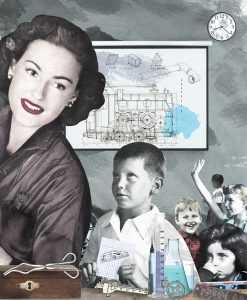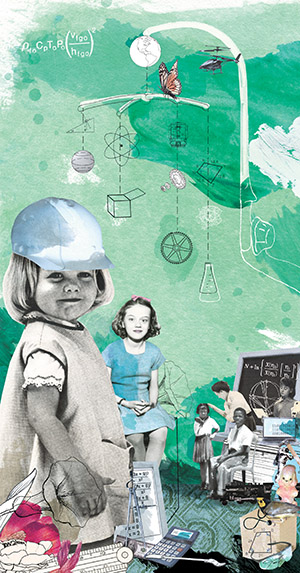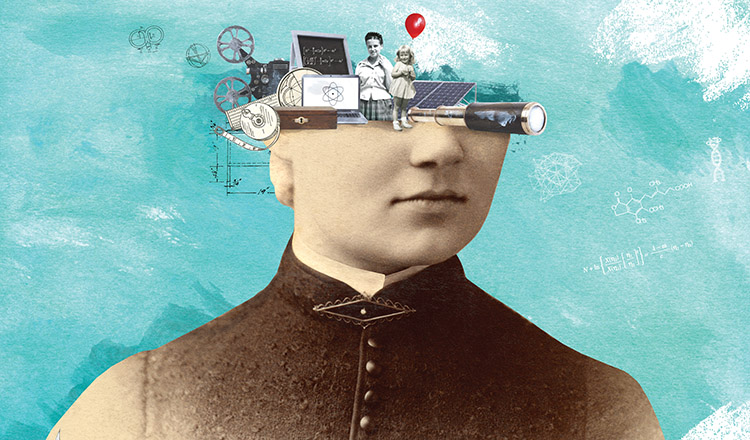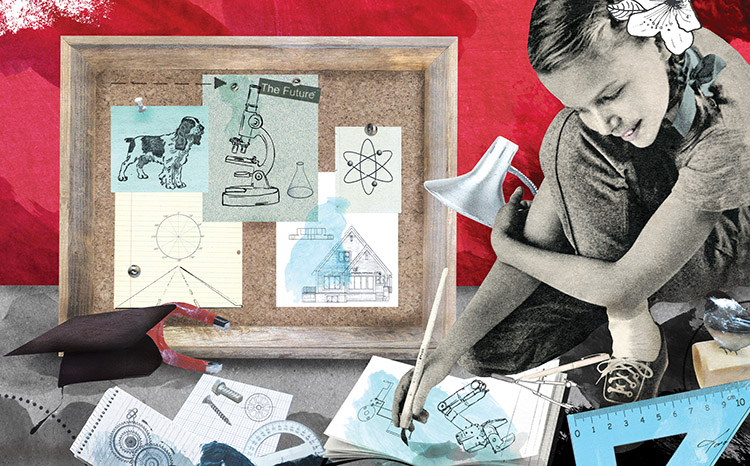Purdue researchers are tackling the challenge of making science, technology, engineering, and math — collectively known as STEM fields — more accessible to young students, and to girls in particular.
As a little girl with an acute interest in science, Brenda Capobianco couldn’t have been born into a better family.
“I’m one of six children, my dad was an engineer, and I was the one who followed him around everywhere,” says Capobianco, whose earliest childhood memories include nature walks with her father to collect rainwater and leaves. “He saw my interest in exploring, and he listened to my questions. He and my mom were very supportive.”
Now an associate professor in Purdue’s College of Education, Capobianco is working to help girls who don’t have the sort of support she had in following her passion — or who might never get the chance to discover that passion in the first place. She’s just one of a number of Purdue researchers tackling the challenge of making science, technology, engineering, and math — collectively known as STEM fields — more accessible to young students, and to girls in particular. Their work is already making an impact on a problem that is as complex as it is enduring.

Capobianco spent a decade as a middle school science teacher before moving into higher education, so she understands the problem better than most. A growing field of research confirms what she saw firsthand: that children absorb and internalize certain biases and stereotypes about gender roles and career choices while still in elementary school. Armed with that knowledge, scientists and educators are digging into how exactly those stereotypes are implanted, and what can be done to overcome them.
“I’m very optimistic,” Capobianco says. “There’s growing awareness of this issue, and I believe teachers are making a concerted effort to meet the challenge.”
Around the state of Indiana especially, they’re doing so with tools and insight provided by Purdue.
Nature vs. Nurture
Sometimes, bias can start with a single word.
Ask a third-grader what an engineer does, and odds are they’ll tell you it has something to do with engines. It’s an assumption that is at once logical and loaded: that same third-grader, no matter their gender, most likely thinks of engines as something built or repaired by men. If that third-grader is a girl, that simple assumption might already be a roadblock on the path to a potential STEM career.
“There’s research that shows that by grade two or three, children become aware of these stereotypes,” says Eric Deemer, an assistant professor in the Department of Educational Studies. “Some people think kids as young as 4 and 5 understand these messages — that girls shouldn’t go into certain occupations because they’re ‘just for boys.’” Intentionally or not, those messages are usually imparted by parents and teachers. In working to better understand the causes and impact, Deemer is focused on examining the issue through the study of stereotype threat — the idea that people feel themselves at risk of confirming a negative perception about their race, ethnicity, or gender. “We’re trying to ascertain the extent to which girls internalize these stereotypes and begin to disengage from these subjects,” he says.

Deemer and Capobianco recently joined forces on research that combines Deemer’s interest in stereotype threat with Capobianco’s focus on identity, and questions whether the two are connected. Their early findings show girls as early as third grade are “very much interested” in STEM fields, but are already saying they don’t foresee themselves pursuing those interests in their careers. Why? The answer is complicated.
Nature does seem to play a role: the science backs up the idea that girls are more inclined to roles that involve compassion and nurturing. Says Capobianco, “Girls want to help.” Back to those third-graders: in one study, Capobianco saw girls who were “highly engaged” with engineering design projects and were then asked if they wanted to be engineers when they grew up. Most said no. Instead, Capobianco says, “They say, ‘I want to be a teacher, I want to be a nurse, I want to be a veterinarian.’” And of course, there’s a social aspect that’s hard to separate: teachers, nurses, and veterinarians are high on a very short list of professionals the average third-grader is likely to interact with.
That reality is reflected in those STEM-related fields where women are well represented, like nursing, biology, and the broader spectrum of life sciences. It’s in fields like physics and engineering where the disparity is most stark, and where questions of bias are especially relevant. That’s where the teachers come in.
Challenges Big and Small
It was the third Friday in January, and Carla Johnson was finally able to exhale. A professor of science education and associate dean for research, engagement, and global partnerships in the College of Education’s Department of Curriculum and Instruction, Johnson was just a day removed from hosting some 600 visitors from nearly 200 schools at the first statewide conference on STEM education. Planning and preparing for the project had dominated recent months, but given the potential to impact so many kids at a young age, she’s certain it was worth the effort. “Getting to them early,” she says, “is really important.”
Johnson cites research that echoes what Capobianco and Deemer have found: waiting even until middle school to expose girls to STEM subjects is too late. “By that point, they’ve probably had bad experiences, and they’re less likely to move into those fields,” she says. “By starting earlier, with a lot of programs targeting those areas, we’re finding that more girls choose to stay in the STEM pipeline.”
Those programs don’t have to be elaborate — Johnson says it can be as simple as implementing problem- or project-based learning, where students are “presented with a big question they have to solve, and they choose where they get to apply their skills.” On a broader scale, teachers are being challenged to make small changes to how they teach, minor tweaks in approach or terminology that can have a potentially massive impact. Johnson talks about the subtle stereotyping that comes in when teachers use “things boys are more interested in, like motorcycles and race cars, in classroom examples,” or the challenge to consciously reference more accessible examples of STEM careers. “It’s the myth that a STEM career means you can only be a physics professor or an astronaut,” she says. “We’ve done a really poor job in K–12 of not dispelling that.”
At the elementary school level, of course, most of the teachers are women — meaning they likely grew up with the same misconceptions, stereotypes, and identity issues they now risk passing on (consciously or not) to their students. Another issue is that they’re not only teaching biology or math — they’re teaching everything. As such, Johnson says, there’s a conscious push to get those teachers to “weave STEM into their curriculum, whether it’s English or social studies. That way, girls are going to start to see that STEM is everywhere, and there’s a lot to it that’s not just the dry old stuff they think they wouldn’t be interested in.”
Ultimately, that’s the goal: to give all children a chance to discover and pursue the subjects that inspire and challenge them, a dream that would benefit not only those kids, but society at large.
There are other challenges that go beyond a teacher’s ability or philosophy. Capobianco says that the increased emphasis in recent years on standardized tests means that for much of the school year, teachers are essentially forced to focus on test prep, leaving little time for subjects like social studies or science. Johnson adds that in Indiana, a student-to-counselor ratio of 614 to 1 in the state’s K–12 schools means limited opportunities for guiding students’ interests and talents. “Part of what we’re trying to do in Indiana is make every teacher a counselor,” Johnson says. “That way, we can try to fold in exposure to STEM careers as early as kindergarten.”
Deemer adds that it’s important to acknowledge the self-perpetuating nature of the problem. In fields that are disproportionately male, girls will have fewer role models to inspire them to take that path, and those who do will have fewer peers to support them along the way. It’s those “chilly environments,” Deemer says — the overwhelmingly male physics department at most universities, say, or a team of mechanical engineers at nearly any large corporation — that show how important it is for women to reach a “critical mass” in those careers. “If women are reluctant to go into those fields, it sort of confirms in the minds of those men that ‘they don’t belong here,’” he says. “Whereas the presence of more women in those fields can be a magnet for young girls.”

Reasons for Hope
Researchers like those at Purdue and elsewhere don’t want to wait for the “magnets.” And as Capobianco says, there’s much to be optimistic about, not least a huge surge in awareness of the issue and the need to address it. Capobianco says the most recent National Science Education Standards, released in 2014, are especially encouraging. “There’s a really strong emphasis in the new standards on science and engineering practices,” she says. “That means every child’s going to have an opportunity to engage in those practices and the related concepts and learning progressions associated with them.”
Capobianco is invested in that approach. As co-principal investigator for SLED, Science Learning through Engineering Design, a National Science Federation-funded program hosted by Purdue, she’s part of a team working with teachers in grades 3–6 throughout Indiana. As she explains, the goal of SLED is to train those teachers how to tie engineering design projects into the daily classroom routine; a favorite of Capobianco’s is a project that challenges students to create a simple machine that would help lift a large dog into the backseat of a car for a trip to the vet. The program has already met its initial goal of having more than 200 teachers and 3,000 students participating.
Of course, the SLED program isn’t only for girls. For all the attention paid to the gender gap, Carla Johnson notes that America’s problem isn’t only in a lack of opportunities for girls in STEM, but for students regardless of gender, particularly those who come from disadvantaged or underserved communities. For that reason, Johnson says that focusing only on girls in STEM isn’t really the point. “I hope we take an approach where every career’s an option for anyone who’s interested in it,” she says.
And ultimately, that’s the goal: to give all children a chance to discover and pursue the subjects that inspire and challenge them, a dream that would benefit not only those kids, but society at large. Eric Deemer didn’t fully appreciate that idea until he was the father of a grade-school daughter. “When she was around 10 years old, I thought, ‘This is a critical time to influence her,’” he says. “That’s kind of how I got interested in this research in the first place.”
His daughter is 17 now, and Deemer laughs when he says “She’s made up her mind — she wants to major in Spanish.” The point, of course, is that there was a choice, and it was hers to make.
Alumna Brings STEM to Life for Girls
Building a candy bridge, creating a baking soda bomb, growing crystals, and making paint bring more than fun to a child’s life. They spark STEM learning through hands-on activities in clubs across the United States and beyond.
Laura Reasoner Jones (EDU’73) launched Girls Excelling in Math and Science (GEMS) a dozen years ago, when she was a teacher, to help elementary and middle school girls claim their places in STEM disciplines. She created a website, gemsclub.org, with everything needed to launch a club, and has been offering it since to teachers, other adults, and girls who’d like to organize a club. No need to register. No fee. Just gather the girls and plan activities that might also include designing chromatography T-shirts, learning to estimate with jars of M&Ms, or mastering hydraulics with Legos.
She focuses on girls because women are underrepresented in STEM careers. That not only limits their opportunities, it shortchanges the world, she believes. “When girls and women are involved, you get more creativity and different points of view.” Her belief: “One GEMS girl may change the world.”
Over the years, she’s updated the GEMS resources, gathered tips from others’ experiences, and expanded the information-packed toolkit document to 92 pages. Downloadable, it covers everything from recruiting members, getting a club started, introducing hands-on activities, inviting guest speakers, and planning field trips. It also lists supplies for activities and suggestions for funding.
“GEMS continues to grow,” Jones reports. Now retired from teaching in Virginia, she lives in Franklin, Pennsylvania, where eight GEMS clubs are “going full blast, serving over 200 girls a year.”
With retirement came the opportunity to devote even more time to the program and make some significant strides, including landing a grant from Google.
“We now have a fiscal sponsor, which allows us to apply for grants and participate in national and international events, and we have become a K-12 affiliate of the National Center for Women and Information Technology, which gets us access to opportunities for girls in computer science.”
GEMS growth goes beyond the number of clubs — there’s no firm tally because it’s a free-access program, but she gets a few e-mails a week with questions and interest — to expanding student age-ranges and STEM areas.
“We are moving into the high schools and increasing the computer science and ‘making’ portions, bringing electronics and soldering and all that good stuff.” —Kathy Mayer

